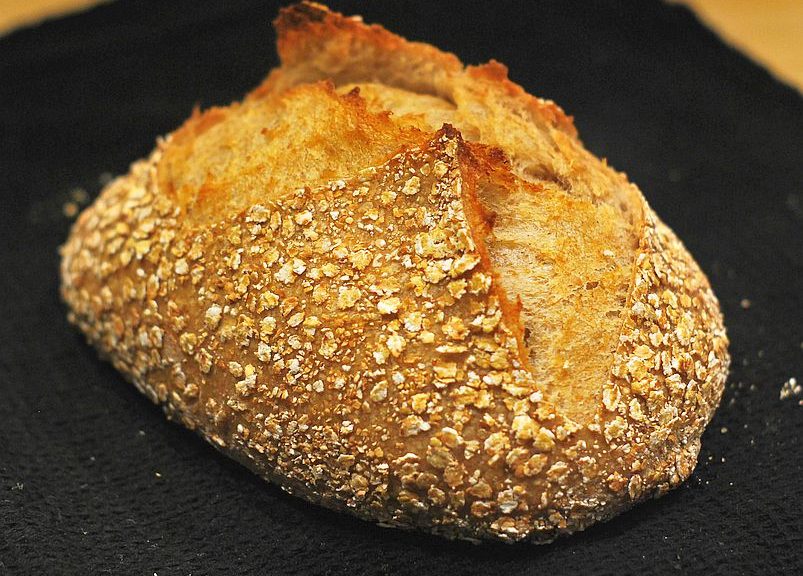
Rustic 3 grains bread with barley sourdough
I call this bread 3 grains because it is built on barley levain, made with wheat flour and buckwheat flakes crust. Also, I call it rustic… well because it is rustic! My wife likes wheat based breads for their open texture and lightness. I on the other hand prefer distinctive flavours of rye or barley. The problem with these grains is that they have very little gluten so the breads based on rye or barley are usually quite dense. This bread is the compromise. I use rye sourdough starter and barley flour to make levain. Then I made dough with wheat flours. The final bake has wonderfully complex flavour yet it remains light and open textured. Buckwheart flakes add extra texture and another dimension to the flavour mix. So if you want best of both worlds – great flavour and light texture give this recipe a go. This bread is fantastic with cheese and chutney as breakfast rolls with bacon and eggs. Simply fingerlicking. Barley flour and buckwheat flakes have been provided by buywholefoodsonline.co.uk .

Makes one small loaf and 8 breakfast rolls or one large loaf.
Ingredients:
- 50g sourdough starter (I use rye but wheat should work as well)
- 420g lukewarm water
- 75g barley flour (https://www.buywholefoodsonline.co.uk/barley-flour)
- 125g brown wheat flour
- 400g strong white flour
- 12g salt
- buckwheat flakes for the crust (https://www.buywholefoodsonline.co.uk/organic-buckwheat-flakes-1kg.html)

Method:
You need to start this recipe in the morning day before you bake.
- First you need to build the levain (pre ferment). Add the sourdough starter, barley flour and 75g water into a large bowl and mix well. Cover tightly with a cling film (or shower cap) and leave for 8 – 12 hours.
- After 8 – 12 hours the levain should be active with visible bubbles on the surface and noticeable sour smell. Add water and remaining flours into the bowl and mix until you have a rough dough. Cover and leave for about 30 minutes. This stage is called autolyse. You will find after a period of time the dough will be much easier to knead and it will become more stretchy.
- Add the salt. The dough is now ready to be kneaded.
- Knead the dough using method described here or mix in a mixer with dough hook attached for about 5 minutes on speed 2.
- Cover the bowl and leave the dough to rest for about 1 hour.
- Transfer the dough onto a lightly floured surface. Pull one side of the dough, stretch and fold inwards towards the middle of the dough. Repeat with the other side of the dough.
- Place the dough back into the bowl, cover and leave for another hour.
- Transfer the dough onto a lightly floured surface. Pull one side of the dough, stretch and fold inwards towards the middle of the dough. Repeat with the other side of the dough.
- Place the dough back into the bowl and cover tightly. Place in a cool place (garage, conservatory, fridge) for 8 – 12 hours (overnight).
- Next morning remove the dough into a heavily floured surface. Divide into 2 equal portions. Fold ends of one portions inwards in similar way as described in step 6. Place it in a bowl, cover tightly and leave for 15 – 30 minutes.
- Divide the other half of the dough into 8 equal portions and roll them into balls. Flatten the balls gently, brush with water and roll in buckwheat flakes (use oat flakes if you can’t get buckwheat ones). Place them on a baking sheet lined with baking paper spaced apart. Cover with tea towel and leave to rest for about 30 minutes.
- Pre heat the oven to 240 centigrade. Place an empty baking tray on the bottom of the oven.
- Meanwhile place the other half of the dough on the floured surface and shape into a loaf. Brush gently with water and roll in buckwheat flakes. Place in banneton or colander lined with tea towel. Cover with cling film (or shower cap) and put in a fridge for another 8 hours.
- When bread rolls are risen place them in the middle of pre heated oven. Pour a cup of boiling water into the tray on the bottom of the oven to generate steam. Bake for 20 minutes. After 3 minutes reduce the temperature to 220 centigrade.
- Remove rolls from the oven and place them on the cooling rack.
- After 8 hours pre heat the oven again to 240 centigrade. Place an empty baking tray on the bottom of the oven. Put a kettle on.
- Dust the top of the proven dough with flour (or even better semolina) so it does not stick to the peel (or baking tray) and you can slide it easily onto the baking stone. Holding bottom of the colander with one hand place your peel (or baking tray) on top of it holding with your other hand. In one rapid movement turn the colander with the peel upside down. Gently remove the colander and then tea towel. You should have your proven loaf on the peel.
- Pour about cup of hot water into the roasting tin on the bottom of the oven. This will create steam that will help your bread to expand and develop a nice crust.
- Make deep slashes on top of your loaf with pattern of your choice. Slide the loaf onto preheated baking stone (or upturned baking sheet). Reduce the temperature to 220 centigrade and bake for about 30 minutes until golden.
- Take it out and tap the bottom. It should sound hollow. Let it cool on a wire rack.
- If you are baking one large loaf skip the part relating to bread rolls and increase baking time to 40 minutes.
